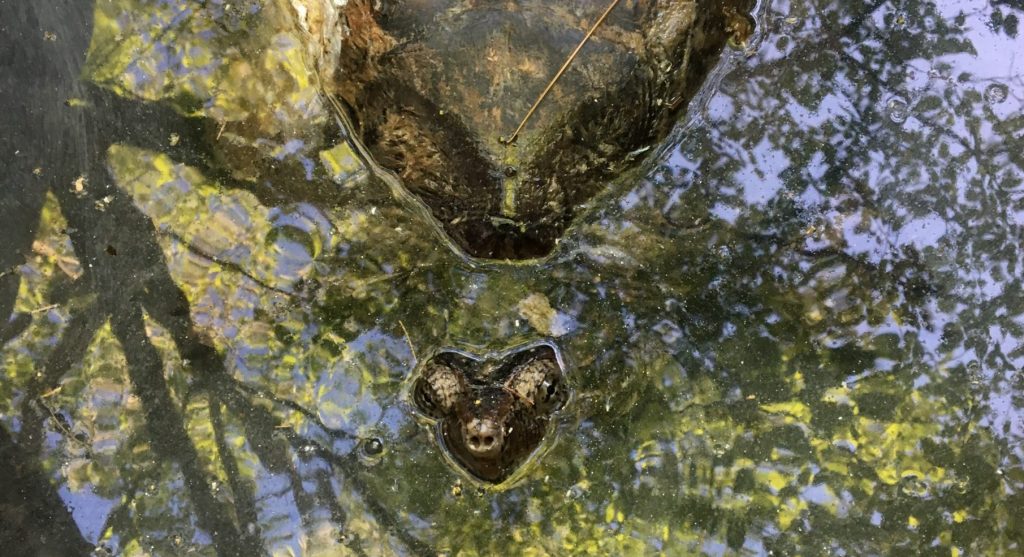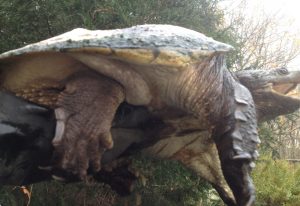
Don't Fear the Turtle.
 What it won’t do is come after you. Why would it? That turtle wants to get away from you. If you treat it with respect and don’t get in its face—literally—a snapper will repay the favor. Why stay away from its face? That long neck is capable of reaching pretty far, and if the turtle does sense that you’ve crossed a line into its personal space and that you do pose a threat, it’s certainly capable of biting you. And those powerful jaws can do some damage. But it’s important to note that, with necks curved like turkey necks, snappers can reach way up, but only a short distance forward or to each side, and not down at all. After all, they evolved to reach prey overhead. So if you keep a safe distance from its head and above its head, it cannot hurt you. And remember, it doesn’t want to!
What it won’t do is come after you. Why would it? That turtle wants to get away from you. If you treat it with respect and don’t get in its face—literally—a snapper will repay the favor. Why stay away from its face? That long neck is capable of reaching pretty far, and if the turtle does sense that you’ve crossed a line into its personal space and that you do pose a threat, it’s certainly capable of biting you. And those powerful jaws can do some damage. But it’s important to note that, with necks curved like turkey necks, snappers can reach way up, but only a short distance forward or to each side, and not down at all. After all, they evolved to reach prey overhead. So if you keep a safe distance from its head and above its head, it cannot hurt you. And remember, it doesn’t want to!
Snapper Dos and Dont's
Don’t ever pick up a snapping turtle by the tail!
You could damage its spine.
Do keep a safe distance from the turtle’s head.
And keep your face far above it if moving the turtle.
Don’t take an adult turtle back to the water.
It’s out of the water for a reason, and knows where it’s going. Submersion may also be lethal to injured animals.
Don’t try to straddle a snapping turtle with your car.
Snappers stand tall when they walk, and the undercarriage of the car can sheer the top off of its shell.
Don’t be afraid to pick up a small snapping turtle.
Hatchlings can’t hurt you, and juveniles are easily handled according to the instructions below.
Do carry a bath or beach towel in your car.
Throw it over the turtle if you need to move it to protect your hands from its claws. Heavy duty gloves also work.
Do carry a large, locking plastic bin in your car.
You may need to transport an injured but active snapper to a rehabber.
Don’t leave an injured snapper behind.
Even mortally wounded they may crawl away, and all injuries require immediate attention.
Don’t judge a snapper’s injury.
Those that look minor can be serious, and those that look fatal often aren’t. Snappers have amazing healing ability when given a chance! A turtle rehabilitator can make the call…and save any eggs she may be carrying.
Don’t interrupt a turtle laying eggs.
If she’s picked a bad spot, call a rehabber to help.
Do keep dogs away from snappers.
They don’t know to keep a distance, and could be bitten.
Don’t take snappers home as pets.
Although there is a season on adult snappers, it is illegal to possess wildlife, and the “cute, little turtle” will outgrow your ability to care for it.
Don’t remove snappers from your pond.
That’s their home, and they actually help maintain the natural balance of the wetland.
How to Pick Up a Snapper<br
To safely move a large snapping turtle, grasp it on either side of its shell between its front and hind legs and lift, taking care to hold it down away from your face, since its head can reach quite a ways up and back, but not far side to side and not down at all. Wearing gloves or placing a towel over the turtle before you pick it up will help protect your hands from its claws, as it will try to “swim” in the air when you pick it up. If the turtle isn’t too heavy, you can also hold it like a platter, with one hand underneath it and the other keeping the back of its shell balanced, as shown below.


